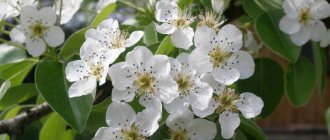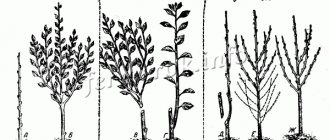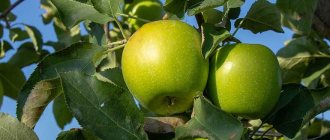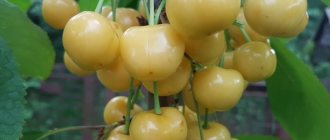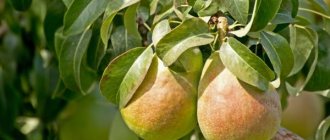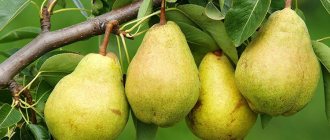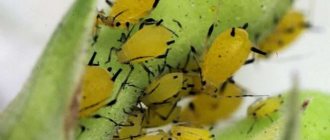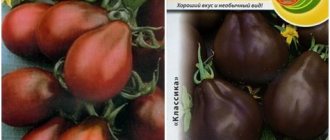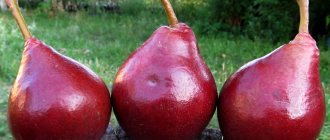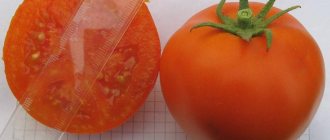The high-yielding pear in Memory of Yakovlev, reviews, variety descriptions and photos of which are presented in the material, is distinguished by excellent frost resistance. For more than 30 years, this variety has been grown in many regions of Russia, including Siberia. To achieve annual abundant fruiting does not require much effort or special skills.
On a note. According to gardeners, the tree is compact and unpretentious. Ripe fruits are picked in early autumn from low-lying branches. Pears have a pronounced aroma, medium juiciness, and oiliness.
History of selection
The Pamyati Yakovlev pear variety was obtained by breeders of the Tambov Research Institute named after. Ivan Michurin in the process of crossing the domestic variety “Tyoma” with the elite of the French selection “Olivier de Serre”. By 1980, a group of scientists consisting of P. Yakovlev, S. Yakovlev, R. Korshikova and Y. Nesterov provided a test specimen for state breeding observations.
By 1985, the prototype confirmed the declared qualities in terms of yield, fruit taste, resistance to scab and low temperatures, and was included in the state register.
On a note. Today, this variety is widespread in various regions and is actively grown in country houses and farms. Used for making dried fruits, compotes, purees, jams.
General description of the variety
Yakovleva pear is a hybrid of Tema and Olivier de Serre varieties
The Yakovlev memory pear was created by crossing such popular varieties as Tema and Olivier de Serre. Since initially high-quality material was chosen for selection, the Yakovlev pear today has a clear description, photos of its fruits adorn the stands of world agricultural exhibitions, and reviews about it are extremely positive.
Trees of this variety usually do not exceed 2 meters in height and are considered low-growing, but they are classified as fast-growing. Their crown is spherical, symmetrical and has moderate neglect. The bark of fruit trees is gray; on young shoots it is smooth, and on skeletal shoots it is flaky.
Pear fruits are distinguished by their juiciness
The crown is characterized by the presence of branches diverging at right angles, which stimulates the process of formation of numerous ringlets. As for the difference between young shoots and old ones, these are numerous thorns. In addition, this variety is characterized by the presence of conical buds. The leaves are dark green, leathery, ovoid, with a serrated edge. You need to focus on these characteristics of the variety when you purchase a Yakovlev pear; its description and photo should always be with you at the time of purchase, so as not to purchase a plant of a different variety.
The flowers of the pear tree are white, large, with separate petals, they are collected in groups of 3-7 pieces. During the fruiting process, the tree bears large fruits weighing about 200 g. They have smooth skin of a characteristic golden yellow or light yellow hue.
The shape of the fruit is usually broadly pear-shaped or obtusely pear-shaped. It is distinguished by resistance to shedding and juicy sweet pulp.
The Yakovlev memory pear begins to bear fruit quite late - 4-5 years after planting in the ground; with proper care, one tree can produce 15-22 kg of fruit. This indicator is not available to all varieties, but it is worth noting that this pear has the ability to self-pollinate, in addition, it is very often used as a pollinator for other varieties.
Fruiting begins in the fourth year
To get a good harvest, it is best to plant 2-3 seedlings side by side. In addition, it is also worth keeping in mind the fact that a small crown allows you to plant seedlings as densely as possible in a relatively small area.
Advice! If your area experiences frequent cold weather, this variety is what you need, because it is not afraid of low temperatures. This is an additional advantage, but it has no significant disadvantages.
Productivity
About 2 kg of fruits are harvested from a young tree in the first year of fruiting. By the 7th year, the yield increases to 20 kg; upon reaching maturity, the tree justifies the characteristic of being high-yielding and brings up to 220 centners of juicy fruits per hectare.
The fruit size is average, reaching 120-130 g.
Pears of this variety are valued for:
- attractive appearance (glossy shine of a light green surface with a small orange tanned side);
- versatility (suitable for consumption fresh, dried, canned).
The harvested crop can withstand transportation due to its dense peel. The variety is not suitable for storage in winter; the maximum preservation of picked fruits is no more than 10-13 days.
Characteristics
Precociousness is low. Fruiting occurs 5 or 6 years after planting the cuttings. Refers to high-yielding varieties . Harvesting takes place in the second half of September.
The following varieties can also boast of high productivity: Yanvarskaya, Duchess, Bere Russkaya, Bere Bosk and Lada.
In cool pear storage facilities at a temperature of 0 degrees Celsius, they can be stored for quite a long time - from 4 months to six months.
Frost resistance is very high.
In the middle of winter at -38 degrees Celsius, when the tree was artificially frozen, the xylem, cambium and bark stem tissues were damaged by 1.1 points.
Important! Due to its high frost resistance, the variety does not require shelter for the winter.
The varieties Pamyati Yakovleva, Karataevskaya, Noyabrskaya, Tonkovetka and Dekabrinka also have excellent frost resistance.
Frost resistance, drought resistance
This variety is often chosen by gardeners from regions with extreme growing conditions for its excellent hardiness. The frost resistance of the crop is rated above average. Recommended temperature range is from +30 to -30 °C. However, according to reviews from summer residents, the tree came to life in the spring even after the temperature dropped to -38 °C.
Recommendation. During the dry period, young seedlings must be watered at least 2 times a week until the soil is wet by 10-15 cm. Adult specimens should be watered once every 10-12 days upon the onset of hot summer. Watering ensures rapid growth and proper development of the ovary.
The hardiness characteristics of the crop were assessed by breeders. It is used as a basis for rootstock when breeding new varieties. The unpretentious and resistant to viral and fungal diseases base allows any scion to develop.
Pear care
Proper feeding three times a day in spring, summer and autumn will be the key to the long life of your fruit tree:
- in spring, use mineral fertilizers that have a beneficial effect on pear flowering;
- in summer there will be enough organic fertilizers;
- In the fall, to restore the strength of the plant after fruiting, add mixtures containing phosphorus and potassium.
Trees 1-2 years old need to be covered if severe frosts are predicted. You can pour water over the pear trunk to form an ice crust. It will protect the tender trunk of the young pear Memory Yakovlev from hypothermia. Photos describing the protection of the trunk from frost are given below.
Ordinary tights are an excellent way to insulate the trunk. Wrap them in several layers around the stem. On top you can put a special net against hares and mice.
If you carefully monitor the condition of your fruit tree, make timely sanitary and anti-aging pruning, and provide abundant watering during the dry months, it will grow healthy and strong. The Memory Yakovlev pear is rightfully considered one of the best varieties for planting in the regions of our country, so you definitely won’t go wrong by choosing it for your summer cottage.
Varieties and comparative characteristics of pear varieties
The varietal varieties were bred by researcher-practitioner P. Yakovlev after obtaining two autumn, partially self-fertile, productive varieties (which are still bred in nurseries today). Their comparative characteristics are presented in the table.
| Name Characteristics | Memory of Yakovlev (photo below the table) | Autumn Yakovleva | Yakovlev's favorite |
| Originator | Scientific Center named after Ivan Michurin | ||
| Year of inclusion in the register | 1985 | 1974 | 1965 |
| Self-fertility | tall, does not require pollinators | partial, Avgustovskaya or Lada are planted nearby for pollination | partial, pollinator is Duchess |
| Winter hardiness | above average | satisfactory | above average |
| Disease resistance | not affected by scab, viruses and fungi | susceptible to scab | susceptible to scab |
| What year does it bear fruit? | 4 | 5 | 6 |
| Tree height | compact up to 3 m | large, spreading, quickly grows to 4-5 m | tall, reaching a height of 6 meters, characterized by a pyramidal crown of medium density |
| Fruit shape | wide pear-shaped | rounded diamond-shaped | rounded diamond-shaped |
| Weight, g | 125 | 150 | 190 |
| Taste | Semi-oily, sweet with sourness, taster rating 4.4 | Sweet and sour with nutmeg aroma, tasting rating 4.9 | The pulp is coarse, not juicy, mediocre taste |
| Maturation | early autumn | mid autumn | mid autumn |
| Advantages and disadvantages | Disease resistance, frost resistance, universal use. | high taste and productivity. | large fruits, winter hardiness. |
Planting Yakovlevskaya pear
Choosing healthy seedlings, knowing and following the rules of agricultural technology is the key to stable harvests.
Pears are planted in an area protected from northern winds, on an elevated place or on gentle slopes on the south side.
Groundwater should lie in an area no higher than 2.5 m from the soil surface.
Deadlines
Pear is a heat-loving crop, the best time for planting is early spring: late March, early April.
In autumn, trees are planted a month before the onset of frost so that they can take root. Low snow winters, unexpected frosts, rodents are negative factors that contribute to the death of young seedlings.
Soil requirements
Pear loves fertile soils, rich in nutrients, warm, of average mechanical composition, cultivated by humans during cultivation. Loam with a neutral environment is best suited.
Peat and humus are added to sandy soils; river sand, peat, and organic fertilizer are added to clay soils.
Planting layouts
The pear is a large tree, light-loving - this requires following the recommended planting scheme: 5x4 m. With a lack of light, the pear produces a poor harvest, the fruits lose their taste.
Preparing the site and seedlings
For spring planting of trees, holes are dug in the fall, and for autumn planting, 2 weeks before planting, so that the earth settles. The holes are marked with dimensions of 60x60 cm and a depth of 50 cm, while the upper and lower layers of earth are folded in different directions.
The roots of the seedlings are not cut, the branches are shortened after planting.
Technological process of planting a tree
The procedure for planting a seedling:
- A stake is placed at the bottom of the hole below the level of the skeletal branches.
- Mix the top layer of soil with a bucket of humus, 200 g of superphosphate, 20 g of potassium sulfate and pour the mixture into a heap at the bottom of the hole.
- Place the seedling on a hill, straighten the roots on the sides.
- Cover with earth and compact tightly.
- Form a hole for watering using 5 buckets of water and water.
- The trunk is tied to a stake in a figure eight to prevent the seedling from swaying in the wind.
The root collar should remain at ground level after watering the soil, the graft should be above the soil on the east side.
Advantages and disadvantages
The pear variety, which has been tested by many gardeners in various regions, has 5 recognized advantages:
- not afraid of frost;
- has a small size;
- does not become covered with scab spots;
- does not require other pollinators;
- gives a bountiful harvest.
The variety has disadvantages: with age, the number of fruits increases, but the quality is lost:
- pears grow in different sizes;
- the pulp develops heterogeneously with hard areas.
- low drought resistance.
Reviews about “In Memory of Yakovlev”
According to gardeners, the variety is more suitable for private cultivation.
- The variety can be grafted . Experiments were carried out on the example of crossing a pear with a wild game. This will require more regular watering and fertilizing. The fruits are juicy and large. Pears taste incredibly delicious.
- The composition of the soil will undoubtedly affect the taste . Tart and bitter fruits grow on sandstone. Juicy and sweet pear grows on loam.
- From the age of three you can expect the first pears . Fruiting is excellent compared to other varieties. You can subsequently engage in resale of young seedlings (shoots). Tolerates frosts well.
- Among gardeners, the “In Memory of Yakovlev” variety is recognized as one of the sweetest and at the same time juicy . However, long-term storage of fruits is contraindicated, and children quickly eat sweet fruits. The young tree bears fruit with a small number of pears. They are all small, but incredibly tasty.
- Perfect for harsh climates , however, this factor will affect the volume of yield. A living example from the Ryazan region.
- There were severe frosts in the Tambov region in 2006, but the pear tree survived them steadfastly. True, the pears were a bit small, but the quantity increased.
Tasting evaluation of fruits
According to professional tasters, the pear has a good taste without astringency, has a uniform (not grainy) texture, and is characterized by medium juiciness. An above-average score is an excellent indicator for a universal culture.
On a note. The pear produces sweet fruit. The sugar content in them is about 12%, the acid is only 0.25%. Pears are beneficial for the presence of ascorbic acid, cahetins and arbutin. Consumption fresh helps improve mood and reduce stress.
Features of planting and growing
To grow a strong, productive tree, it is important to choose the right place according to the following characteristics:
- loamy soil with neutral or low acidity (alkaline soils are unsuitable);
- good lighting throughout the day (the proximity of tall trees is undesirable);
- protection from through air flows;
- distant occurrence of groundwater (it is undesirable to plant a tree near springs, rivers, and reservoirs).
The Yakovlev Memory Pear, planting and caring for which does not require much effort, quickly develops and begins to bear fruit.
For normal growing season, it requires watering in hot weather:
- Once a week after landing,
- 2 times a month, 3 buckets of water in the circle around the trunk when reaching maturity.
It is advisable to apply fertilizers for the 3rd year, after good rooting. You can use an infusion of bird or cow droppings.
Pests and diseases
In memory of Yakovlev, the tree has a fairly strong immune system, but if not properly cared for, the tree can still encounter a number of diseases. Among the main problems of this variety it is worth noting:
- White leaf spot. When a tree encounters this disease, white or gray spots form on its leaves, which then turn yellowish and fall off. This disease is treated with Bordeaux mixture or special fungicides. The tree must be treated before flowering.
- Black cancer. If a pear tree encounters this disease, the bark on its trunk begins to crack and crumble. Subsequently, the entire tree dries out. To prevent black cancer, you need to constantly whitewash the trunk. Diseased areas are treated with a solution of copper sulfate.
- Fruit rot. If a tree is faced with this disease, then characteristic brown spots appear on its fruits. This leads to drying and shedding of the fruit. Fallen fruits must be removed from the site. The wood itself is treated with Bordeaux mixture.
Memory Yakovlev often encounters parasites. Unfortunately, while some pears can be protected from specific diseases, there is no 100% natural immunity from parasites. The main pests for this variety are:
- Aphid. This is the main parasite that infests the tree and has the most negative impact. The pest can be controlled using special insecticides. Another problem with aphids is that they attract black garden ants to their area. Previously, when there were no insecticides, gardeners fought aphids using traditional methods, for example, treating the tree with a solution of garlic and dandelion, or a solution of laundry soap.
- Pear copperhead. This insect lays its eggs in bark and leaves. As a result of the parasite's activity, the tree begins to grow more slowly, and the fruits grow small and tasteless. To combat this parasite, you can use the same folk remedies - a solution of garlic and dandelion or a soap solution.
- Pear moth. This pest feeds on the fruits of the tree. After an infestation by these insects, it is imperative to remove the fruits that the codling moth has attacked. The tree itself must be treated either with special insecticides, or with a solution of wormwood.
